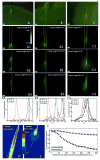Multipoint-emitting optical fibers for spatially addressable in vivo optogenetics
- PMID: 24881834
- PMCID: PMC4256382
- DOI: 10.1016/j.neuron.2014.04.041
Multipoint-emitting optical fibers for spatially addressable in vivo optogenetics
Abstract
Optical stimulation and silencing of neural activity is a powerful technique for elucidating the structure and function of neural circuitry. In most in vivo optogenetic experiments, light is delivered into the brain through a single optical fiber. However, this approach limits illumination to a fixed volume of the brain. Here a focused ion beam is used to pattern multiple light windows on a tapered optical fiber. We show that such fibers allow selective and dynamic illumination of different brain regions along the taper. Site selection is achieved by a simple coupling strategy at the fiber input, and the use of a single tapered waveguide minimizes the implant invasiveness. We demonstrate the effectiveness of this approach for multipoint optical stimulation in the mammalian brain in vivo by coupling the fiber to a microelectrode array and performing simultaneous extracellular recording and stimulation at multiple sites in the mouse striatum and cerebral cortex.
Copyright © 2014 Elsevier Inc. All rights reserved.
Figures






References
Publication types
MeSH terms
Grants and funding
LinkOut - more resources
Full Text Sources
Other Literature Sources
Molecular Biology Databases

